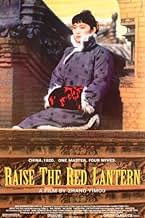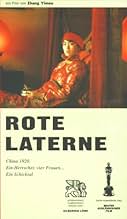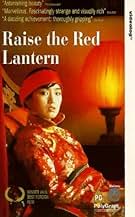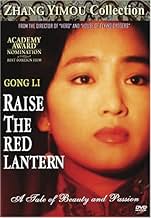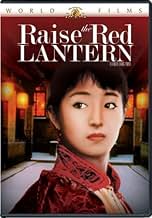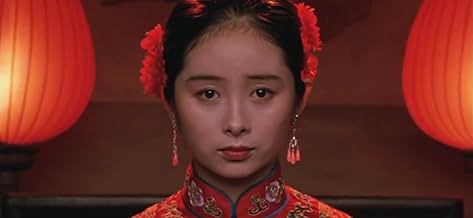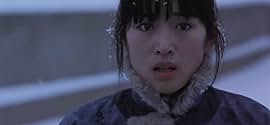NOTE IMDb
8,1/10
37 k
MA NOTE
Une jeune femme devient la quatrième épouse d'un riche seigneur et doit apprendre à vivre avec les règles strictes et les tensions du foyer.Une jeune femme devient la quatrième épouse d'un riche seigneur et doit apprendre à vivre avec les règles strictes et les tensions du foyer.Une jeune femme devient la quatrième épouse d'un riche seigneur et doit apprendre à vivre avec les règles strictes et les tensions du foyer.
- Réalisation
- Scénario
- Casting principal
- Nommé pour 1 Oscar
- 23 victoires et 15 nominations au total
Zengyin Cao
- Old Servant
- (as Zhengyin Cao)
Zhigang Cui
- Dr. Gao
- (as Zhihgang Cui)
Espérance Pham Thai Lan
- Kids - Concubines
- (non crédité)
Avis à la une
10gbheron
"Raise the Red Lantern" is set at a Chinese baronial estate, the time, the 1920s. But, as the family-servant dynamics are placed on display, the viewer begins to feel it could be a thousand years earlier. The story is shown through the eyes of a young college-dropout played by Gong Li. Family misfortune has forced her into concubinage as the "fourth mistress" of the Chinese lord. A headstrong woman, her relationship with the lord's household, especially the other three mistresses, form the basis of the story. But it's telling is as important as the story itself. This is a beautiful, well-acted, well-directed movie. Slow-paced, it ingratiates itself with you, drawing you in deeper and deeper. I can't think of anything that warrants improvement. A masterpiece.
I had a good day, so I selected this film. I have several films that I reserve for good days because I know they will reward. Its a sort of celebration that will send me into rich dreams, annotating my life.
This has two known qualities that you, dear reader, can expect without knowing anything about the film itself.
First, you will know that this is a woman directed by someone deeply in love with her. This doesn't always produce great films, but when the director is inherently cinematic, it often evokes something deep in the viewer. There is nothing in the world like looking on the face the person you are centered on. A million subtle decisions are made in each scene, summing to an effect that cannot be missed. If this had poor narrative qualities (and some of their films did) it would still have this quality of seeing into a soulmate deeply enough to be able to animate the skin.
Its quite interesting when you consider the woman. If you see her outside of film, or in films made by ordinary eyes, she is quite ordinary. She has an atypical Chinese body: busty and widehipped. She is poised but doesn't have the neck or cheekboned face of other Asian women. Only under this man's eye is she a goddess. You can see this in the very first shot.
The second thing you can count on is the architectural anchoring of the thing. This man knows how to use space. He uses it in the cinematic narrative, for example, if you replay the shots where the house of death is shown, and then the last encounter with it... And if you understand why the decisions about handling distance and surfaces were made they way they were, you will have entered a zone where from now on you will not be able to reason without reasoning with place.
But there are other handlings of space: As with some of his other films, the building is a character. Its the noir narrator who sets the rules often arbitrary under which all characters are bound to operate, and which drives the narrative. Its a particularly western notion, this, and has gotten our hero in trouble, even banned. This part is following Welles and Kubrick.
But he goes further than either of them with this notion that the light both has agency of its own (it selects which of the four wives gets a foot massage and sex) and is a part of the fabric of the buildings. The redness changes the spaces it occupies, bringing intrigue with the sex, desire for several things. Its quite layered, what is going on. These lanterns are the real master; in fact the person who inhabits the master's body is hardly even there. We never see his face.
Because of the extensive use of hard planes and selfish light, there aren't many fabric effects here, as we'll see elsewhere.
I am tempted to designate this as one of my two allowed "must see before you die" films of 1991. But I'm in too good a mood to make such a serious decision.
Ted's Evaluation -- 3 of 3: Worth watching.
This has two known qualities that you, dear reader, can expect without knowing anything about the film itself.
First, you will know that this is a woman directed by someone deeply in love with her. This doesn't always produce great films, but when the director is inherently cinematic, it often evokes something deep in the viewer. There is nothing in the world like looking on the face the person you are centered on. A million subtle decisions are made in each scene, summing to an effect that cannot be missed. If this had poor narrative qualities (and some of their films did) it would still have this quality of seeing into a soulmate deeply enough to be able to animate the skin.
Its quite interesting when you consider the woman. If you see her outside of film, or in films made by ordinary eyes, she is quite ordinary. She has an atypical Chinese body: busty and widehipped. She is poised but doesn't have the neck or cheekboned face of other Asian women. Only under this man's eye is she a goddess. You can see this in the very first shot.
The second thing you can count on is the architectural anchoring of the thing. This man knows how to use space. He uses it in the cinematic narrative, for example, if you replay the shots where the house of death is shown, and then the last encounter with it... And if you understand why the decisions about handling distance and surfaces were made they way they were, you will have entered a zone where from now on you will not be able to reason without reasoning with place.
But there are other handlings of space: As with some of his other films, the building is a character. Its the noir narrator who sets the rules often arbitrary under which all characters are bound to operate, and which drives the narrative. Its a particularly western notion, this, and has gotten our hero in trouble, even banned. This part is following Welles and Kubrick.
But he goes further than either of them with this notion that the light both has agency of its own (it selects which of the four wives gets a foot massage and sex) and is a part of the fabric of the buildings. The redness changes the spaces it occupies, bringing intrigue with the sex, desire for several things. Its quite layered, what is going on. These lanterns are the real master; in fact the person who inhabits the master's body is hardly even there. We never see his face.
Because of the extensive use of hard planes and selfish light, there aren't many fabric effects here, as we'll see elsewhere.
I am tempted to designate this as one of my two allowed "must see before you die" films of 1991. But I'm in too good a mood to make such a serious decision.
Ted's Evaluation -- 3 of 3: Worth watching.
Zhang Yimou solidifies his standing as one of cinema's most brilliant craftsmen with Raise the Red Lantern, a heartbreaking and fascinating look into the life of a young, well-educated woman who gives up her future to become the fourth wife of a wealthy landowner in 1920s China. Gong Li, the director's longtime muse, delivers a performance nearly unsurpassed by anyone, male or female, in the 1990s (and many other decades, as well). Her opening close-up is an indelible image of sorrow and resignation capable of drawing tears out of a statue. Zhang Yimou makes films as exquisitely composed as any master's painting, and his palette extends beyond the obvious beauty of Gong Li to include the details of the courtyards, lanterns, silks, and rooftops with an inexplicable mixture of tranquility and austerity.
Just another, in a very, very long list of films that document the abuses and misery suffered by women - this time in 1920s China but take a decade of any country and you'll find a plethora of these films. It's a shame that such a huge amount of material exists in the first place, let alone that it continues to this day. That said, the visuals are spectacular, the acting sublime, it is a beautiful thing to behold and the message is well and truly received and understood: we know who is in charge!
10jonr-3
My interest was maintained throughout every minute of this rather long film. I don't remember when I've seen another film in which every single role was played to perfection. (Incidentally, this wonderfully believable acting seems to occur in at least some, if not most, of the roles in every Chinese movie I see, from the mainland or otherwise.)
The story is one of classical simplicity, in in large part presented with the same classical, clear quality. The interplay of passion, jealousy, and revenge is reminiscent of Shakespeare, but, for me, more entertaining--if it's proper to speak of such ultimately somber and even horrifying subject matter as entertainment.
I unhesitatingly gave a vote of ten, and noticed that a full 33% of voters so far had done the same--very unusual.
When Roger Ebert called "Raise the Red Lantern" "breathtakingly beautiful," he wasn't exaggerating. But beyond its beauty, its moral seriousness, the fact that not for a moment is it "dumbed down" in the regrettable Hollywood fashion, its superb acting, and its almost unbelievably perfect pacing, make it a rare, rare experience.
"Red Sorghum," the only other Zhang Yimou film I've seen so far, I found somewhat propagandistic but gripping and visually stunning (even more so than "Raise the Red Lantern.") I will be making an effort to see more of this director's fairly extensive body of work.
It's a shame major theater chains don't schedule movies of this caliber instead of the torrent of commercialized Hollywood trash they foist on the public, which, alas, seems only too eager to wallow in more and more of it.
The story is one of classical simplicity, in in large part presented with the same classical, clear quality. The interplay of passion, jealousy, and revenge is reminiscent of Shakespeare, but, for me, more entertaining--if it's proper to speak of such ultimately somber and even horrifying subject matter as entertainment.
I unhesitatingly gave a vote of ten, and noticed that a full 33% of voters so far had done the same--very unusual.
When Roger Ebert called "Raise the Red Lantern" "breathtakingly beautiful," he wasn't exaggerating. But beyond its beauty, its moral seriousness, the fact that not for a moment is it "dumbed down" in the regrettable Hollywood fashion, its superb acting, and its almost unbelievably perfect pacing, make it a rare, rare experience.
"Red Sorghum," the only other Zhang Yimou film I've seen so far, I found somewhat propagandistic but gripping and visually stunning (even more so than "Raise the Red Lantern.") I will be making an effort to see more of this director's fairly extensive body of work.
It's a shame major theater chains don't schedule movies of this caliber instead of the torrent of commercialized Hollywood trash they foist on the public, which, alas, seems only too eager to wallow in more and more of it.
Le saviez-vous
- AnecdotesFilmed at the Qiao Family Compound near the city of Pingyao. The complex is now open for tours, however, nowhere is there any mention of the film.
- GaffesAround 01:18:59, there is a lot of smoke in front of the third wife. And there is almost no smoke in front of the second one.
- Citations
The Third Concubine: Good or bad, it's all playacting. If you act well, you can fool other people; if you do it badly, you can only fool yourself, and when you can't even fool yourself, you just can fool the ghosts.
Meilleurs choix
Connectez-vous pour évaluer et suivre la liste de favoris afin de recevoir des recommandations personnalisées
- How long is Raise the Red Lantern?Alimenté par Alexa
Détails
Box-office
- Montant brut aux États-Unis et au Canada
- 2 603 061 $US
- Week-end de sortie aux États-Unis et au Canada
- 22 554 $US
- 15 mars 1992
- Montant brut mondial
- 2 603 061 $US
- Durée2 heures 5 minutes
- Couleur
- Rapport de forme
- 1.85 : 1
Contribuer à cette page
Suggérer une modification ou ajouter du contenu manquant

Lacune principale
By what name was Épouses et concubines (1991) officially released in Canada in French?
Répondre

